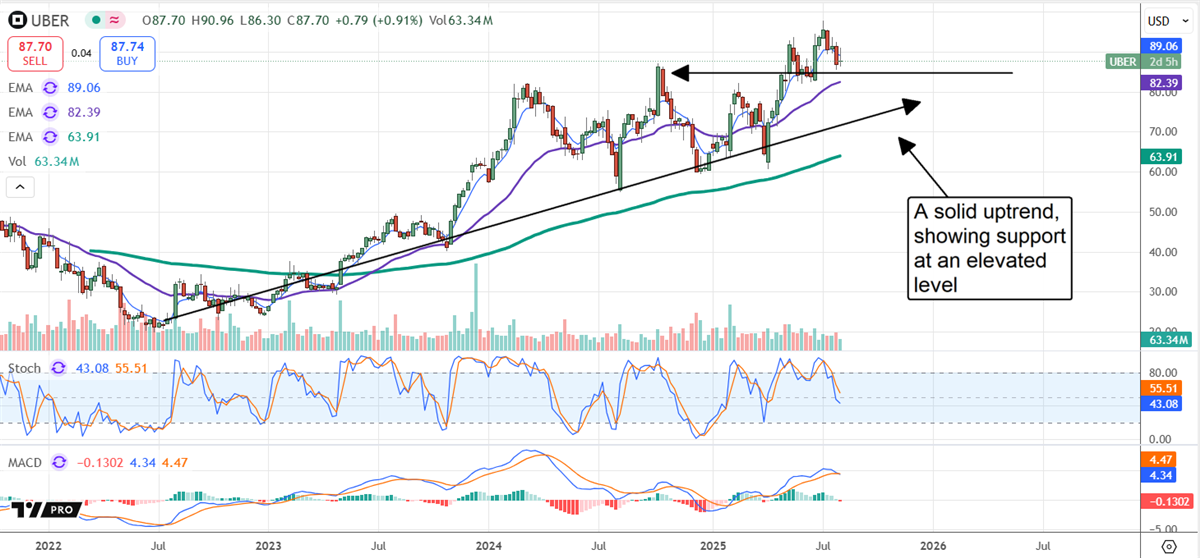Ticker Reports for August 7th
4 Semiconductor Stocks Earning Fresh Wall Street Upgrades
Over the past weeks, important players in the semiconductor industry have reported earnings, with several names putting Wall Street estimates to shame. This caused analysts to lift their price targets significantly.
These updates hint that the semiconductor rally may still have legs, especially as end-market demand improves and long-term themes like AI and automation remain intact. Below, we highlight four companies whose recent earnings and revised analyst outlooks stand out.
Latest Targets Significantly Boost Lam’s Implied Upside
First up is semiconductor manufacturing equipment giant Lam Research (NASDAQ: LRCX), which released earnings on July 30. The company posted big beats on both sales and adjusted earnings per share (EPS). However, shares still fell more than 4% afterward as worries remain around the company’s business in China. This didn’t deter Wall Street from issuing significant upgrades.
MarketBeat tracked nearly ten analysts who lifted their targets on July 31 and Aug. 1. On average, these analysts increased their price targets by more than $10. Overall, the MarketBeat consensus price target on Lam is around $107, implying around 9% upside.
However, the average target among those analysts who updated their forecasts is nearly $113. This figure indicates substantially more upside, suggesting shares could rise nearly 15%. TD Cowen is notably one of the stock’s biggest bulls. Their $125 target implies 27% upside potential in this chip equipment stalwart.
PI Surges +25% on Earnings, European Law Is a Big Potential Tailwind
Next is Impinj (NASDAQ: PI). This company makes small chips and related devices that help track the movement of goods. This helps customers with things like inventory management and theft prevention.
Impinj blew past expectations in Q2, causing shares to gain by a whopping 26% on July 31. MarketBeat also tracked several analysts who lifted their targets on the stock on July 31, doing so by an average of 30%. However, analysts seem to believe that the market has now priced in the stock’s gain.
The MarketBeat consensus price target in Impinj is around $163, indicating shares are fairly valued. Still, Impinj has a key tailwind that could allow it to deliver significant upside longer-term: the European Union’s Digital Product Passport (DPP) law. The DPP legislation requires that every product sold or made in the region is trackable throughout its lifecycle.
Impinj’s technology could help companies comply, especially in its number one market: textiles. The law starts applying to textiles in 2027, which could drive big-time sales for Impinj.
MPWR Is No Stranger to Proving Wall Street Wrong
Monolithic Power Systems (NASDAQ: MPWR) shined in Q2. The company delivered better-than-expected results on the top line, bottom line, and guidance. This led shares to surge more than 10% on Aug. 1. All but one analyst tracked by MarketBeat boosted their price target on the stock in August.
Overall, these analysts increased their price targets by an average of $42. The average price target among those who issued updates comes in at $850, moderately higher than the stock’s $838 consensus target. The updated $850 target implies around 2.3% upside. However, opinions range widely.
Wells Fargo’s $750 target suggests around 10% downside, while KeyCorp’s $950 target implies over 14% upside potential. Still, Monolithic has delivered far above the upside that Wall Street previously forecasted. On May 7, Wall Street only saw 14% upside in shares. However, since that point, the stock has provided a total return of nearly 31%.
Additionally, MPWR has seen its shares rise after nine out of its last 12 earnings releases. It’s not crazy to think the company could continue to outperform Wall Street expectations.
Cadence Delivers in Q2, Gets Notable Upgrades
Electronic automation design software company Cadence Design Systems (NASDAQ: CDNS) has also seen a notable boost in sentiment. In Q2, the company beat expectations on sales, adjusted EPS, and raised its full-year guidance.
This helped shares post a nearly 10% gain on July 29, and MarketBeat tracked several analysts who raised their price targets.
The MarketBeat consensus target on Cadence is just $364, almost exactly equal to the stock’s closing price on Aug. 4. However, focusing on price targets updated after earnings changes the picture.
The average target among those analysts is $389, implying nearly 7% upside.
Although not groundbreaking, it is certainly a big improvement over the consensus forecast.
Analysts Recalibrate as Chip Stocks Outperform Expectations
Overall, these four names are clearly moving in the right direction. Their latest results showed that Wall Street underestimated them, and analysts are now scrambling to raise their price targets. While Monolithic’s track record of topping expectations stands out, the rest of the group is also showing signs of strength.
Impinj has a long-term tailwind that could prove its recent rally is just the beginning. Lam’s weakness on earnings day may have been overdone. And Cadence is back on the radar after another solid beat. If these trends continue, analysts may still be playing catch-up.
A Trump Order Could Send This $7 Stock Soaring
A Trump Order Could Send This $7 Stock Soaring
Buybacks Over Dividends? These 2 Stock Picks Make a Strong Case
There are typically two ways for investors to see the benefits of stock investing. One of them (and the most common) is buying low and selling high for a profit. However, there comes a time when investors find that one company they never want to let go of, no matter how much of a run higher they’ve already experienced, and that is where the second method comes into the equation.
That is, dividend payouts, though attractive to some, seem to be a much better option for a company's growth and compounding value. Not to mention that dividends aren’t the most efficient method of rewarding shareholders.
A much better way to see the benefits of owning a company is through stock buybacks, and the reasons for their superior efficiency will become clear soon.
Before those are laid out, investors should note that two companies have recently announced stock buyback programs, which could lead to further upside potential and other important insights.
These names are Bank of America Corp. (NYSE: BAC) and Dollar Tree Inc. (NASDAQ: DLTR) to spread a bet around the financial sector as well as the retail sector.
Why Buybacks Beat Dividends Every Time
When investors receive a dividend, they are then obligated to pay a tax on that income, and this is where the inefficiency starts to show up. Dividends are paid through company profits, which have already been taxed at that business’s corporate tax bracket, therefore creating a twice-taxed event.
More than that, this capital is essentially leaving the company, taking away its ability to reinvest in itself and spur a new growth wave through acquisitions or paying down debts to increase net income margins. Stock buybacks are often the more advantageous and less discussed way to reward shareholders, mainly because they are not taxed. They directly increase each shareholder’s ownership in the company, whose pie is shrinking with larger pieces for everyone, not to mention these also act as tailwinds for valuations and earnings per share (EPS) growth.
That being said, here is what a new stock buyback program may imply for the future of Bank of America and Dollar Tree.
A New Buying Spree for Bank of America
After approving a new stock buyback program to buy $40 billion worth of Bank of America stock, insiders are telling retail investors that the bank's future is brighter still, even after a rally of 11.5% over the past quarter, sending the stock to 93% of its 52-week highs.
The bank’s management wasn’t the only player in town looking to be exposed to this further upside potential. Institutional buyers from Cooke & Bieler decided to double their holdings in Bank of America stock, bringing their entire position to a high of $151.5 million today, roughly 15% of the $1.1 billion of institutional buying this quarter so far.
As expectations for a future interest rate cut rise, it can be assumed that a commercial bank like Bank of America will benefit from the demand that comes through mortgages and credit cards, among other such products, boosting earnings in the process.
Here's what’s interesting about this bank: even if the Federal Reserve takes longer to lower interest rates, deposits—which are high at commercial banks—can be further monetized through increased net interest income (NII). This might be why management is aiming to build on this momentum, along with institutional buyers.
Even Wall Street analysts are aware of this path higher, as they now forecast $1.06 in EPS for the second quarter of 2026, a decent rise of 19% from today’s reported $0.89 in EPS, giving investors a new fundamental reason to consider this stock.
Tariff Fears Fade for Dollar Tree
As trade tariff negotiations between the United States and most other countries advance, it appears that smaller players in the retail sector are finding new reasons to catch their breath and start a rally to catch up with the rest of the S&P 500 index.
Dollar Tree is one of these names, rising by 38% over the quarter to show investors just how much positive momentum is in this new macro theme. For the same reasons, centered around a confident future, management laid out a stock buyback program of $2.5 billion to reward those willing to stick around until the volatility fades.
Although the consensus recommendation is to Hold and the target price of $97.7 per share suggests a 15.5% decline from current levels, a few Wall Street analysts have taken a more realistic stance.
Matthew Boss and Seth Sigman from J.P. Morgan Chase and Barclays see Dollar Tree stock as an Overweight valued at $138 per share.
This contrasting view gives investors the chance to tag along with management for an implied additional upside of 20% from today’s already bullish price action.
$100 Trillion "AI Metal" Found in American Ghost Town
$100 Trillion "AI Metal" Found in American Ghost Town
Uber Technologies Is Driving Cash Flow: Ride It Higher for Life
Uber Technologies (NYSE: UBER) started as a risky new technology and has developed into a blue-chip quality stock whose business is entrenched in society. The single factor that most summarizes that quality is its capital return, which has been robust and is getting richer by the year.
The company’s business, operational quality, and growth trajectory led the board to authorize another, larger-than-before share repurchase authorization worth $20 billion or roughly 10% of the early August market cap. The takeaway is that Uber Technologies is no longer a risky tech start-up but now a buy-and-hold quality tech stock whose stock price has significant room to run.
Buybacks and Growth to Lift Uber Stock by Triple Digits
Uber’s share buybacks are not trivial. While not aggressively reducing the count, the Q2 activity resulted in a 1.1% reduction compared to the prior year and is expected to continue offsetting share-based compensation moving forward.
The question is whether the company will accelerate its buying or maintain a steady pace, and when a dividend payment may be forthcoming. Comparable stocks that turn cash flow into buybacks and dividends tend to see their share prices trend higher over time.
The valuation metrics suggest this stock could rise by 400% to 600% over the next 10 years. The stock trades at 32x its current year's earnings outlook, aligning with blue-chip peers, but its growth forecasts are much more robust.
The forecast is for a sustained high-20% to high-30% earnings CAGR for at least the next decade, which puts the business near 5x earnings by 2035.
Assuming that Uber continues to build on its technological advantages, outperforming consensus estimates for quarterly results, the long-term forecasts are too low, and the value is deeper than it appears.

Although some caution has crept into the analyst's outlook, the sentiment trends remain positive and align with an uptrending share price. The activity leading into the Q2 release includes several downgrades to Hold-equivalent ratings offset by price target increases that lead to the high-end range.
The consensus of 38 analysts is a high conviction Moderate Buy rating, with more than 70% rating it as a Buy. The price target forecasts a 10% upside. The high-end range puts this market near $120, another 20% upside, and both the consensus and high-end are sufficient to set fresh all-time highs.
Uber Skids on Mixed Results
Uber’s share price slipped following the Q2 release due to the mixed results. The company outperformed on the top line, growing revenue by nearly 19% to outpace MarketBeat’s reported consensus by 185 basis points, but missed targets on the bottom line.
The bottom-line miss is due to increased investment in business acquisition and growth, so it is not a major sticking point for the market. The more critical details include the 18% increase in trips and gross bookings, the 35% increase in adjusted EBITDA, the 35% increase in adjusted earnings, and $2.5 billion in free cash flow.
Regarding the free cash flow and share buybacks, the Q2 results put the payout ratio at a very sustainable near-50%.
Uber’s stock price uptrend is intact despite the post-release price dip. The market retreated but did not fall below a critical support target until early August. The market may consolidate at this level and move sideways in the near term, but it is unlikely to set a new low; if it does set a new low, investors should expect to see it rebound quickly.
Not only are there billions in authorized buyback dollars, but the institutions have been buying robustly and will likely continue to do so. They own more than 80% of the stock and provide a solid support base and tailwind for market action.
This stock could leave NVDA in the dust
This stock could leave NVDA in the dust






0 Response to "🌟 Buybacks Over Dividends? These 2 Stock Picks Make a Strong Case"
Post a Comment